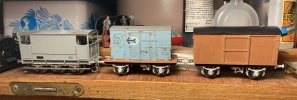AJC
Western Thunderer
Very nice. I’ve a pair of the sprung Stenson bogies made up too. Just need a suitable project to put them under!
I have things in boxes much like that. Not among my better habits...
Adam
Very nice. I’ve a pair of the sprung Stenson bogies made up too. Just need a suitable project to put them under!


Hello Adam,I rather like this one.
Adam
Hello Adam,
As ever with your work, so do I. I'm particularly enamoured with your triptych of Opens. And the close ups of your wagons reminds me that I must pay more attention to the colouration of the underpinnings. The ply van exhibits a spectrum of hue and shade which speaks of your mastery of application, observance, and understanding.
Cheers
Jan


Adam, can you see the bottom of the wagon draw yet? I'm so impressed about how many you get completed.A pair of kits from the drawer,
Adam, can you see the bottom of the wagon draw yet? I'm so impressed about how many you get completed.
Do you ever put suspension units in wagons, vans, etc or just have a degree of movement in the wheel axle bearings to take up any minor irregularities?



Yes, it's very easy to get distracted by random pathways.........A small diversion, occasioned by the LNER van (the roof was too small for purpose). A BR plywood BK container - one of the ones with end doors only - to diagram 3/125. The carcass has been knocking around for years, and now I’ve popped the lid on, it’s been marked out for details, which will mostly have to be 5 thou’, which is a bit of a trial, but essential. Of course, having done this, I’m looking at other diagrams and pre-Nationalisation designs… I really shouldn’t.
View attachment 216846
Adam
Yes, it's very easy to get distracted by random pathways.........
Tim T
Interesting. You saw that recent one over on The Clearing House? I thought it might be LMS...Especially, in this case, because most modellers stick by what they can get: Parkside's excellent BD and FM, or Bachmann's nicely made accessories (again, BDs and various A types), or the various Airfix/Mainline ones. Why not knock up some proper LNER or SR RCH spec' types which were relatively distinctive? Of course you have to chain the wretched things down...
Adam
Interesting. You saw that recent one over on The Clearing House? I thought it might be LMS...
Incidentally, what do you use for sticking down your 5 thou? I onlly have Plastic Weld ATM, and that's a tad viscious...
Cheers
Jan
